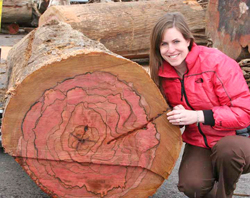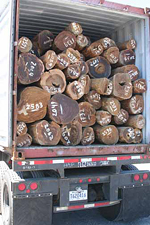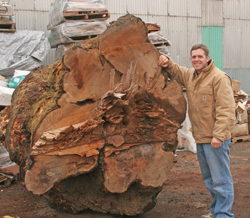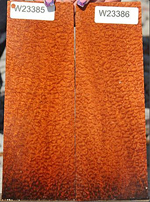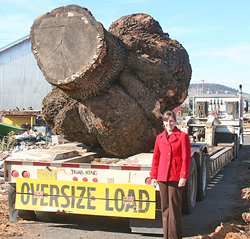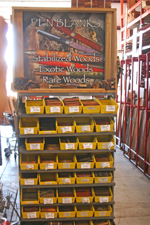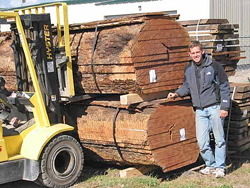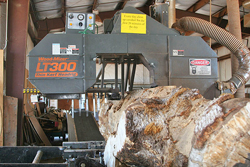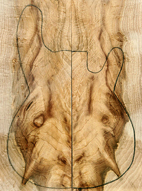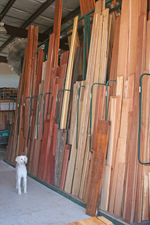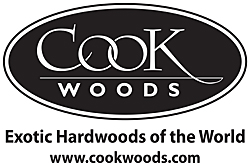
When a single African bubinga log sells for $64,000 at auction, being the winning bidder might just feel like you’re buying diamonds rather than wood. But, a 78-in. diameter, 14-ft.-long specimen with waterfall figure doesn’t come along just any old day. And when you’re in the business of selling exotic woods and other rare lumber, you have to get your new inventory while the getting is good.
But high-stakes log buying is all in a day’s work for Chris and Catherine Cook, founders of Cook Woods in Klamath Falls, Oregon. And even if a log costs much, much less than a bubinga giant, what the Cooks are after are those prized finds, whether native to the U.S. or from all corners of the globe, that offer exquisite figure and grain patterns for their customers.
“Sometimes it feels like ours is more of a jewelry business than a lumber company,” Chris admits, when considering that the availability of some particularly hard-to-find woods may only be a few trees at a time. It’s like buying precious gemstones. “You may only get one opportunity…then you have to weigh that over against whether customers will buy it or if it will sit in the warehouse for a long time. There’s definitely an element of risk to it.”
Take one of the rarer woods (snakewood) Chris uses an example. He’s only had some in inventory three times in the company’s 14-year history. It comes from the rainforests of northeastern South America, and logs are long but in small diameter. The wood’s stiff structure and vibrant grain pattern make it highly prized for violin bows, walking canes and other fine projects. Still, it’s very hard to get out of the forest, Chris says, “and you have to go way off the beaten path to find those trees these days. Then, milling it into useable material produces a lot of waste. We sell it by weight more than by the foot.” A single snakewood pen blank can cost anywhere from $5 to $15.
But for Chris, rarity isn’t the only criteria that influences what he buys. He’s also motivated by a strong sense of environmental ethics. “I like forests to continue to be forests, and I have a degree in wildlife biology. When I can, I buy logs that would otherwise go to waste with other logging companies.” Chris recounts that he once bought a 200-year-old, 8-1/2-ft. -diameter Sitka spruce tree that was destined for a pulp paper mill. “That one log yielded lots of boards that were two to four feet wide.” Plantations grown for other trees are often where Cook gets some of his best madrone and myrtlewood. These trees and others are often considered “collateral damage” for loggers pursuing other species that are in greater demand.
“I’ve travelled around the world and have seen forests and ecosystems being wasted. So, in our business, we’re trying to offer what could get thrown away. Salvaging and preserving precious woods really encompasses what we do as a company.”
Chris says he tries to buy logs from “low-impact” suppliers and from loggers with a reputation for adhering to sustainable harvesting guidelines. Sometimes a source might use mule teams or helicopters rather than skidders and other earth-damaging machinery to extract the logs, in order to spare the surrounding habitat.
One of the bigger public relations challenges when selling exotic woods is combatting a misperception that his business is emptying the rain forests of threatened trees. The bigger threat, Chris says, is quite the opposite. “When there’s no value on something, there’s no reason to keep it alive … and that goes for trees, too. The best thing that could happen for some types of exotic lumber is if its demand would increase and the cost would go up. When there’s a value for it, trees doesn’t get burned down or cleared for livestock production and agriculture.”
Chris asserts that what’s causing the demise of Brazilian rosewood, for instance, isn’t woodworking. “It’s coffee production. Native forests are being wiped out for coffee plants. These days, we woodworkers use a miniscule amount of rosewood by comparison. The second cause is that Brazilian rosewood was once used excessively for making caskets, back in the 1940s through the 1970s. The trees weren’t replanted. When it takes from 100 to 300 years for new trees to grow to maturity, rosewood can’t be renewed in a single lifetime.”
Over the years, Cook Woods has amassed an impressive lumber list of some of the world’s more unusual wood species, ranging from amazique to ziricote, and some 260 species in between. Currently, Chris estimates that the company has upwards to a half million board feet of lumber available, and another 80,000 to 100,000 board feet in logs waiting to be milled. He prefers to buy wood by the log, so he can mill and dry it to Cook Woods’s standards using Wood-Mizer equipment and a 5,500-board- foot-capacity kiln. “I really love sawing up logs, and my passion is milling logs into lumber for musical instruments and rifle stocks.” Cook also says he has a closely guarded secret for “pressure cooking” some species, such as madrone, that eliminates internal tension which could otherwise ruin the wood.
There really is no “typical” customer for Cook Wood’s exotics. The company sells wood to everyone from crafters making crochet needles or earrings, to woodworkers, luthiers and musical instrument companies. Cabela’s bought 800 of Chris’s claro walnut fly fishing boxes to mark their 40th anniversary, back in 2000 when he still had time for woodworking. David Marks has been a customer, “and Sam Maloof bought a lot of our ziricote several years before he died. We once drove our semi to his house so he could look through our supply.”
But whether a sale is one piece of stock or a thousand board feet, to a first-timer or a regular buyer, Chris says the company’s philosophy is to take care of customers. He’s willing to photograph individual pieces of wood for those who want to see exactly what they are buying, and he’s taken more than a million of these photos over the years for customers and the company website. A free newsletter, which advertises weekly specials, is also very popular, and the special typically sells out quickly. The company website is easy to navigate, with many photos and extensive descriptions of wood for sale. It’s a comprehensive customer experience the Cooks have fostered in response to less-than-stellar experiences themselves.
“There’s often a big disconnect between sellers and buyers. We’ve learned how NOT to run our company by buying from other lumber companies … that’s why we do our absolute best to be spot-on accurate, and to source our inventory sustainably and ethically. We take care of customers the way we want to be treated.” Those guiding principles, plus an evaluation of a variety of other industry-specific criteria, led Wood-Mizer Products to award first place honors to Cook Woods last year in its 2012 Business Best contest.
Learn more about Cook Woods by clicking here.
